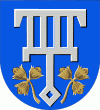Lohja
 |
City's bilingual slogan is: Järvikaupunki - Insjöstaden which translates to "Lake city".
The landscape of Lohja is characterized by manors and gardens. Its area is divided by the Lohja ridge, which forms a watershed for the largest lake system in Uusimaa, Lake Lohja (Lohjanjärvi); mostly that's why Lohja is also referred to as "Lake City" (järvikaupunki). The medieval Church of St. Lawrence is the architectural highlight of downtown Lohja, which also includes a heterogeneous mix of buildings mostly dating from the 1960s onwards. The Lohja library, which was opened in 2005, is a distinctly modern building
Lohja has been a focal point for the population and economy of western Uusimaa since the early 14th century. The local inhabitants were among the pioneers of the Finnish mining and construction material industries. Lohja has long-established traditions in horticulture and especially in market gardening. These traditions are represented by the
During the Second World War, the Soviet Union heavily bombed the city,
Map - Lohja
Map
Country - Finland
 |
 |
| Flag of Finland | |
Finland was first inhabited around 9000 BC after the Last Glacial Period. The Stone Age introduced several different ceramic styles and cultures. The Bronze Age and Iron Age were characterized by contacts with other cultures in Fennoscandia and the Baltic region. From the late 13th century, Finland became a part of Sweden as a consequence of the Northern Crusades. In 1809, as a result of the Finnish War, Finland became part of the Russian Empire as the autonomous Grand Duchy of Finland, during which Finnish art flourished and the idea of independence began to take hold. In 1906, Finland became the first European state to grant universal suffrage, and the first in the world to give all adult citizens the right to run for public office. After the 1917 Russian Revolution, Finland declared independence from Russia. In 1918, the fledgling state was divided by the Finnish Civil War. During World War II, Finland fought the Soviet Union in the Winter War and the Continuation War, and Nazi Germany in the Lapland War. It subsequently lost parts of its territory, but maintained its independence.
Currency / Language
| ISO | Currency | Symbol | Significant figures |
|---|---|---|---|
| EUR | Euro | € | 2 |
| ISO | Language |
|---|---|
| FI | Finnish language |
| SV | Swedish language |

















